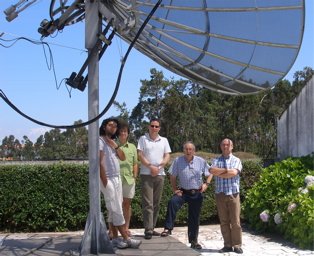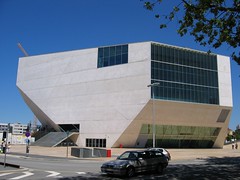I spent the week before last in Portugal working with the team designing and building the GEM telescope: The Polarized Galactic Emission Mapping Project in Portugal. GEM (aka GEM-P or even P-GEM-P) aims to measure the emission of our Milky Way galaxy using light at a wavelength of 6 cm. Those frequencies are dominated by synchrotron emission, generated by electrons deflected by the magnetic field of the galaxy. These measurements will give us invaluable information about the structure of the galaxy. Moreover, this emission is an important contaminant for the cosmological maps that experiments like the Planck Surveyor and its successors like the BPol project that many of us have just proposed to the European Space Agency.
GEM-P is being built mostly by a small group at the Instituto de Telecomunicações and the Universidade de Aveiro. Here’s me with a large part of the Aveiro team:
That’s Rui Fonseca, Domingos Barbosa, me, Dinis Magalhães and Luis Cupido. This wasn’t taken at the GEM-P lab, by the way, but in Luis’s backyard, and that’s the 5.5 meter dish he keeps there to play with and do things like track NASA spacecraft in the outer reaches of the solar system!
Aveiro is a lovely town (even The New York Times agrees) experiencing a pretty remarkable building boom that manages to combine a high-tech University with an old-fashioned fishing village. For me, that meant the useful combination of pretty ubiquitous wifi and great seafood. (More pictures of Aveiro here).
(I also got to spend some time wandering around Porto, where I stayed right down the road from Rem Koolhaas’s new Casa de Musica, just shortlisted for the RIBA Stirling Prize. Photos of the older bits of Porto here.)
